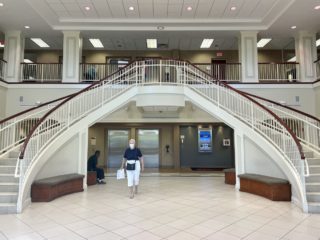Blepharoplasty
The eyelids are small but delicate structures integral to protecting and maintaining the health of the eye. As we age, the skin thins out, tissues stretch and sag, and the face loses volume. The first place this becomes apparent is often the eyelids. This excess, puffy, or lax skin can make you appear more tired or older than you are. Eyelid surgery, or blepharoplasty, can give the eyes a more youthful look by removing excess skin, bulging fat, and lax muscle from the upper eyelids. The excess skin and fat are removed through an incision hidden in the natural eyelid crease, which is then closed with fine sutures. Sagging upper eyelids may also interfere with vision by partially or completely obstructing the pupil. In these cases, insurance companies may cover blepharoplasty surgery.
Ptosis/Droopy Eyelids
Ptosis is the medical term for drooping of the upper eyelid or lids. This lowering of the upper eyelid margin may cause a reduction in the field of vision if the eyelid either partially or completely obstructs the pupil. Patients with ptosis often have difficulty keeping their eyelids open. To compensate, they will often arch their eyebrows in an effort to raise the drooping eyelids. In severe cases, people with ptosis may need to lift their eyelids with their fingers in order to see.
As we age, the tendon that attaches the levator muscle, the major muscle that lifts the eyelid, can stretch and cause the eyelid to fall. This represents the most common cause of a droopy eyelid. Ptosis may also occur following routine LASIK or cataract surgery due to stretching of this muscle or tendon. Patients may also be born with ptosis, or may acquire it due to trauma or neurologic reasons.
Ptosis can be corrected surgically and usually involves tightening the levator muscle to elevate the eyelid. In severe ptosis, when the levator muscle is extremely weak, a “sling” operation may be performed, enabling the forehead muscles to elevate the eyelid. Other types of repair may include surgery on the muscle on the inside of the lid in cases of small amounts of ptosis. The surgeon will perform testing determine the best form of correction for the individual patient. The goal is to elevate the eyelid to permit a full field of vision and to achieve symmetry with the opposite eyelid.
Entropion
Entropion is a condition in which the eyelid is rolled inward toward the eye. It can occur as a result of advancing age and weakening of certain eyelid muscles. Entropion may also occur as a result of trauma, scarring, or previous surgeries. A turned in eyelid rubs against the eye, making it red, irritated, painful, and sensitive to light and wind. If it is not treated the condition can lead to excessive tearing, mucous discharge and scratching or scarring of the cornea. A chronically turned in eyelid can result in acute sensitivity to light and may lead to eye infections, corneal abrasions, or corneal ulcers. If entropion exists, it is important to have it surgically repaired before permanent damage to the eye occurs.
Ectropion
Ectropion means that the lower eyelid is “rolled out” away from the eye, or is sagging away from the eye. The sagging lower eyelid leaves the eye exposed and dry. If ectropion is not treated, the condition can lead to chronic tearing, eye irritation, redness, pain, a gritty feeling, crusting of the eyelid, mucous discharge, and breakdown of the cornea due to exposure. Generally the condition is the result of tissue relaxation associated with aging, although it may also occur as a result of facial nerve paralysis (due to Bell’s palsy, stroke or other neurologic conditions), trauma, scarring, previous surgery or skin cancer. Ectropion can be repaired surgically with little, if any, post-operative discomfort.
Eyelid Tumors
The eyelid skin is the thinnest and most sensitive skin on your body. As a result, this is often the first area on your face to show change from sun damage and aging. Unfortunately, sun damage and other environmental toxins not only cause the skin to age but can cause serious damage. Skin cancer of the eyelids is relatively common and several types exist. The presence of a nodule or lesion on the eyelid that grows, bleed or ulcerates should be evaluated. This involves examination and sometimes a biopsy. Growths that are determined to be cancerous typically can be cured by excision followed by reconstruction of the defect left behind after tumor removal. Sometimes the surgeon will perform this themselves at a surgical facility with an on site pathologist who can immediately examine the specimen to ensure the whole tumor was removed. Other times, the help of a dermatologic surgeon specializing in Mohs surgical excision will be utilized. This procedure is completed into two steps, the first in the dermatologist’s office with immediate examination of the tumor to ensure its complete removal followed by the reconstructive surgery by your surgeon. For those tumors that are more aggressive and require more involved care to ensure complete treatment, your surgeon will help coordinate this as part of your treatment depending on the size, type, and circumstances of the tumor at presentation.
Eyelid Reconstruction
Eyelid reconstruction may be undertaken in a variety of situations. Defects in the eyelid may arise from a variety of situations, but most commonly after trauma or tumor excision.
In some instances, such as after traumatic injuries or removal of larger growths or skin cancers, larger defects may extend through the entire lid. Many of these can be sutured together directly, but many others may require more complex reconstructions



